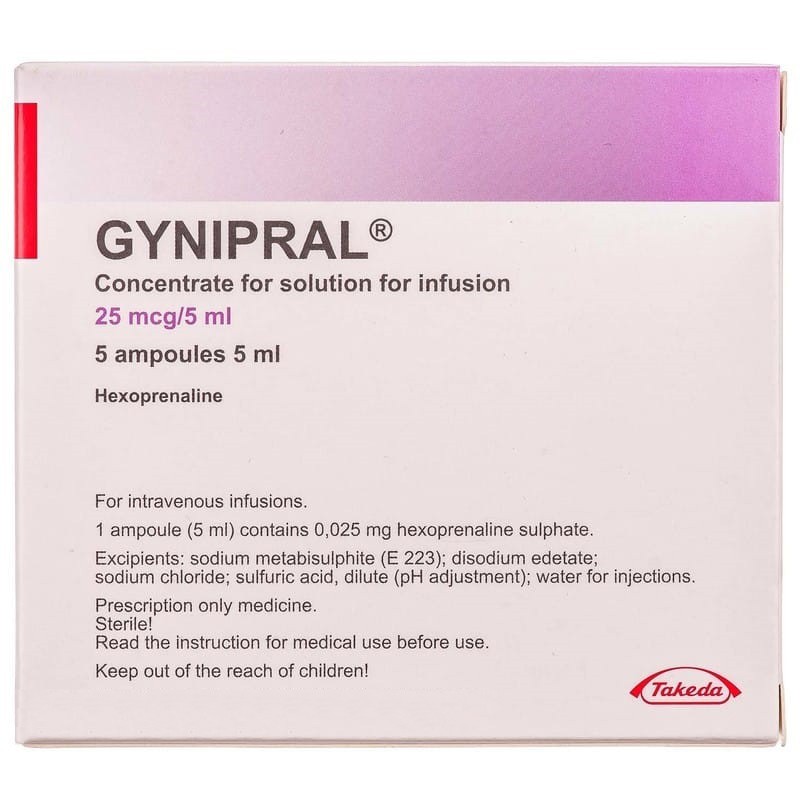



 Secure and encrypted payment processing
Secure and encrypted payment processing We ship to over 40 countries including the USA, UK, Europe, Australia and Japan
We ship to over 40 countries including the USA, UK, Europe, Australia and Japan Guaranteed refund or reship if you haven't received your order
Guaranteed refund or reship if you haven't received your orderGynipral is a selective β2-sympathomimetic that relaxes the muscles of the uterus. under the influence of Gynipral, the frequency and intensity of uterine contractions decreases. the drug suppresses spontaneous, as well as labor pains caused by oxytocin. during childbirth normalizes very strong or irregular contractions. under the action of Gynipral, premature contractions in most cases stop, which allows you to extend the pregnancy to the normal term of delivery. suppression of labor pain is observed immediately after iv administration of the drug and lasts about 20 minutes. the effect of the drug increases after a subsequent drip of the drug. due to its β2-selectivity, Gynipral has an insignificant effect on the cardiac activity and blood circulation of the pregnant woman and the fetus.
Pharmacokinetics The drug consists of two catecholamine groups that undergo methylation in the human body due to catecholamine-O-methyltransferase. If the action of isoprenaline almost completely ceases with the introduction of one methyl group, hexoprenaline becomes biologically inactive only in the case of methylation of both of its catecholamine groups. This property, as well as the high ability of Gynipral to adhere to the surface, is considered to be the reason for its prolonged action.
When using hexoprenaline for the first 4 hours, 80% of the active substances are excreted unchanged in the urine, that is, in the form of free hexoprenaline and monomethyl derivative. After this, the excretion of dimethyl derivative and related compounds (glucuronide and sulfate) increases. A small part is excreted with bile in the form of complex metabolites.
After dilution for iv injection or infusion.
Dissolve the concentrate for infusion in 500 ml of 0.9% sodium chloride solution or 5% glucose solution.
Dosage calculation: 0.3 mcg / min corresponds to
| The number of ampoules, n (mcg) | I / O rate, drops / min |
|---|---|
| 1 (25) | 120 |
| 2 (50) | 60 |
| 3 (75) | 40 |
| 4 (100) | 30 |
When using automatically dispensing infusomats, 75 μg (3 ampoules of concentrate for infusion of 25 μg Gynipral) are diluted with 0.9% sodium chloride solution or 5% glucose solution up to 50 ml, the infusion rate is 5 = 0.3 μg / min. The daily dose of 430 mcg is exceeded only in exceptional cases.
When using automatically dispensing infusomats, 75 μg (3 ampoules of concentrate for infusion of 25 μg Gynipral) are diluted with 0.9% solution of sodium chloride or 5% solution of glucose to 50 ml, infusion rate 3 = 0.075 μg / min.
Enter as an infusion (20 drops = 1 ml). Dissolve the concentrate for infusion in 500 ml of 0.9% sodium chloride solution or 5% glucose solution.
Dosage calculation: 0.075 mcg / min corresponds to
| The number of ampoules, n (mcg) | I / O rate, drops / min |
|---|---|
| 1 (25) | 30 |
| 2 (50) | 15 |
Use the prepared solution within 24 hours. If the contractions do not resume within 48 hours, treatment can be continued with Gynipral in the form of 0.5 mg tablets. The indicated dosing can only be used as an approximation, with tocolysis it is necessary to adjust it individually.
Incompatibility. Sulfite is a highly active component, so you should refrain from mixing Gynipral with other solutions, except for 0.9% sodium chloride solution and 5% glucose solution.
Hyper